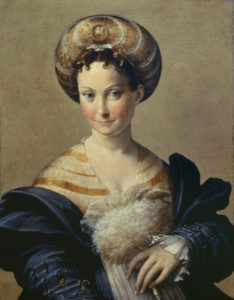The creative energy of the Italian Renaissance was such that even minor cities produced geniuses. Out of the northern Italian city of Parma, for example, came two greats: Correggio and Parmigianino.
Correggio, born Antonio Allegri, lived from 1489 to 1534 and is probably best known for his illusionistic ceiling perspectives. In these, entire domes of cathedrals seem to disappear in rings of clouds and soaring angelic figures.

Parmigianino’s “The Turkish Slave.”
His pupil, Parmigianino (Girolamo Francesco Maria Mazzola), lived a mere 37 years – from 1503 to 1540 – but long enough to dazzle everyone with his talent. His best known work, “Madonna With the Long Neck,” typified the aristocratic, gorgeously artificial style that evolved out of the High Renaissance – mannerism.
Like other Renaissance artists, Correggio and Parmigianino painted their greatest works on walls and ceilings – masterpieces that are anchored to Italian soil. But, both were also exceptional and prolific draftsmen, and their works on paper have found their way all over the globe. About 130 of them, from public and private collections in England and North America, have been gathered into an exhibit at the Metropolitan Museum of Art in Manhattan.
Like his elder contemporary Leonardo da Vinci, Correggio favored red chalk and the technique of sfumato – the seamless blurring of tone and outlines “in the manner of smoke [fumo],” as Da Vinci described it.
Parmigianino was a fluent and prolific draftsman who could dash off draft after draft of a compositional idea – 30 sheets alone for his “Madonna of Saint Jerome” altarpiece. He was frequently compared to Raphael, who had died in 1520. “It was said that the spirit of Raphael had passed into Parmigianino’s body,” said artist biographer Giorgio Vasari.
Although Parmigianino has about three-quarters of the works in this show, Correggio holds his own. His red chalk drawings have such a delicate touch that the forms seem to coalesce without benefit of lines, without any border between light and shadow. In the gently erotic “Venus Asleep,” Correggio practically carves the edge of the figure out of red chalk, while doing very little internal modeling. The sleeping figure sinks into a drapery, one knee raised up, her head resting on one arm.
With Correggio, even the awkward passages are somehow endearing. In “A Man Riding a Bull, and Other Figures,” a black chalk drawing done with a soft sfumato technique, the nude rider’s head is slightly askew on his shoulders, as is the bull’s. But this lends the drawing an unaffected innocence.
In “Adoration of the Shepherds,” he created a painterly feeling of light and color by working white gouache and brown wash into the red chalk. The gouache is applied so subtly that you hardly notice it, but it creates a sense of forms bathed in a beautiful light.
Parmigianino drew like an angel, whether it was a martyred saint, the god Mercury, or one of the numerous self-portraits. The most youthful one of these shows a sensitive, almost feminine face, with large liquid eyes, a full mouth, and a hat of soft cloth resting gently on the head. He could make forms emerge from shadow, like Correggio, and he could depict any sort of perspective illusion or foreshortening, as could be seen in a rear view of a horse raising its front hoofs in the air.
His elegant rendering of a man’s naked torso stretches out the form, which suggests that it was a study for a crucified Christ. His landscape sketch has the poetry of an invented place, with windswept trees that look like twirling ostrich plumes.
In “Bearded Man Sleeping,” we feel a Michelangeloesque weight and volume, and in his fluid sketch of a standard-bearer, the sinuous movement of the lithe youth is amplified by the rippling, billowing flag he holds.
The abundance of Parmigianino drawings is attributed not just to energy and virtuosity, but to a problem in completing commissions. In the last decade of his life, the making of endless studies became a form of procrastination. Some scholars blame Parmigianino’s mental problems on a passion for alchemy, which may have exposed him to nerve-damaging mercury. At one point, disgruntled patrons had him thrown into prison. He died fleeing from another imprisonment threat.
“Correggio and Parmigianino” brings together the works of two temperamentally different artists linked by place, by the master-pupil relationship, and by a love of drawing. Which of the two you admire more depends on whether you prefer the artist who feels his way along a new path or the one who develops it into a more self-conscious style.
Metropolitan Museum of Art
2001

